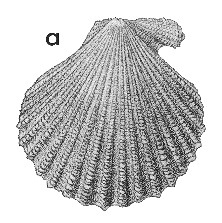
Revised descriptions of New Zealand Cenozoic Mollusca from Beu and Maxwell (1990)

 | Revised descriptions of New Zealand Cenozoic Mollusca from Beu and Maxwell (1990) | 
|
  (Pl. 10a): GS1341, I40/f6492, Waitaki River, opposite Wharekuri, Duntroonian (GNS) |
Beu & Maxwell (1990): Chapter 10; p. 144; pl. 10 a.
Synonymy: Pecten chathamensis Hutton 1873b, p. 29; Cyclopecten compitum Marwick 1929, p. 909; Chlamys compitum; Chlamys (sensu lato) chathamensis, Beu & Maxwell 1990, p. 144
Classification: Pectinidae
Description: Size moderate for genus (height 25-40 mm), considerably higher than long, only moderately inflated. Ears very unequal, anterior ears much the larger, dorsal margins colinear but markedly oblique to axis of symmetry of disc. Byssal notch deep and wide, fasciole very prominent, sunken; ctenolium present. Radial sculpture on disc similar in both valves, of 20-27 (mean 22) prominent, simple, rather wide, scaly costae or plicae of rounded or subtriangular cross-section. Interspaces without secondary costellae, sculptured by growth lines and antimarginal striae, which are more prominent towards ends than in middle of disc. Ears with about 4 narrow, scaly costellae.
Comparison: Mimachlamys williamsoni (Whaingaroan, south-west Auckland) is similar to M. chathamensis but has more numerous radial costae (24-27, mean 26) (Boreham 1965, p. 22). The undivided primary ribs on both valves are a character used by Waller (1991) to distinguish tribe Mimachlamydini, and it seems likely that "Chlamys" chathamensis and C. williamsoni are New Zealand species of Mimachlamys Iredale, 1929, along with the unnamed Eocene species illustrated by Maxwell (1992, p. 65, pl. 3g-i). The details of the microsculpture (forming a herringbone pattern where antimarginal and commarginal ridges intersect in Mimachlamys), the early microsculpture on the preradial area of the left valve (shallowly pitted in Mimachlamys), and whether internal rib carinae (characteristic of Mimachlamydini and all other scallops more advanced than Chamydini) are present will need to be determined to confirm this position (research now in progress).
Distribution: Duntroonian; "Broken River" (type locality of P. chathamensis, probably from the '"Fan coral bed", Thomas Formation, junction of Porter and Thomas Rivers, Castle Hill Basin); Chatton Formation, Shell Gully, Chatton (type locality of C. compitum); Wharekuri Greensand, Waitaki River, opposite Wharekuri. Common only at the last locality. Despite the name this species is not known from the Chatham Islands, although it is a reasonable assumption that Hutton intended the type to be from there (Boreham 1965, p. 21).
Cite this publication as: "A.G. Beu and J.I. Raine (2009). Revised
descriptions of New Zealand Cenozoic Mollusca from Beu and Maxwell (1990). GNS
Science miscellaneous series no. 27."
© GNS Science, 2009
ISBN
978-0-478-19705-1
ISSN 1177-2441
(Included with a PDF facsimile file
copy of New Zealand Geological Survey Paleontological Bulletin 58 in CD version
from: Publications Officer, GNS Science, P.O. Box 30368 Lower Hutt, New
Zealand)